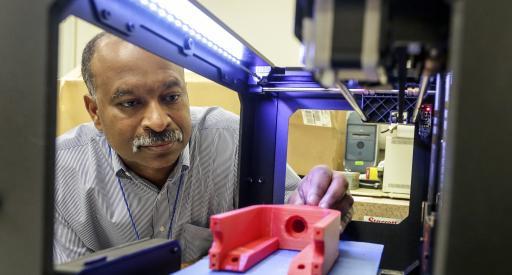As part of his daily work as a scientist at the Princeton Plasma Physics Laboratory (PPPL), Bob Ellis sometimes fields calls from organizations like the Korea Supercomputing Tokamak Advanced Research (KSTAR) facility. In this case, the need was for a water-cooled fixed mirror with an ability to stand up under intense heat for as long as five minutes as microwave beams are directed from launchers in order to fuel fusion reactions through heated plasma.
And that’s exactly the sort of thing that is right up Ellis’ alley.

Ellis examines the plastic prototype for his mirror design.
Ellis has experience building mirrors that don’t use coolant for use in shorter experiments and that history led him to believe that 3D printing would be the best approach to creating this new component. What was new for Ellis was the approach of using 3D printing to create a metal component. Head of the Mechanical Engineering Division at PPPL, Phil Heitzenroeder, explained the decision to utilize metal printing, something that PPPL had not previously done:
“Metal came into 3D printing about five years ago and was sort of exotic then. Now 3D is beginning to drift down into real-world metal products.”
 While this may be the case, to most people, the creation of water-cooled mirrors capable of heating plasma to fuel fusion reactions may still seem somewhat other-worldly. In any case, the ability of 3D printing to create metal components that do not require much to finish their processing and are generated as a unified whole made it the ideal approach for such a high-stress component.
While this may be the case, to most people, the creation of water-cooled mirrors capable of heating plasma to fuel fusion reactions may still seem somewhat other-worldly. In any case, the ability of 3D printing to create metal components that do not require much to finish their processing and are generated as a unified whole made it the ideal approach for such a high-stress component.
The first step was the creation of a CAD-CAM model that delineated the form of the shoebox-sized system. The model was then sent to Imperial Machine and Tool for production in stainless steel and copper via 3D printing. The 70-year-old machining company has embraced additive manufacturing technologies alongside its traditional metal working equipment. The president of the company, Christian Joest, reported that the system took approximately 20 hours to produce, from the addition of the talcum-powder-like substance to the printer to its removal from the machine.
For this particular component, 3D printing was a perfect fit as it otherwise would have had to be produced in several pieces and then assembled. Those assembly points would create possibilities for weakness and would have required that the cooling channels could be drilled before assembly. Instead, a thin sheet of polished copper was layered directly on top of a base of stainless steel in a form that integrated the water cooling channels necessary for the component’s function.
KSTAR has been so satisfied with the result that they have come back to Ellis again to design a mirror that can be steered by computer in order to direct microwaves into particular areas of the heated plasma. What do you think about this technology? Discuss in the Microwave Launcher forum thread on 3DPB.com.
Subscribe to Our Email Newsletter
Stay up-to-date on all the latest news from the 3D printing industry and receive information and offers from third party vendors.
You May Also Like
Immensa and Pelagus 3D Collaborate to Tap “$2 Billion” 3D Printing Opportunity
Dubai’s Immensa, which claims to be the “largest digital manufacturer” in the Middle East/North Africa (MENA) region, has formed a strategic collaboration with Pelagus 3D, a Singapore-based, on-demand digital manufacturing...
US Army Contracts 3YOURMIND & Phillips Corp. for 3D Printed Tank Parts Identification
The US Army Combat Capabilities Development Command (DEVCOM) Ground Vehicle Systems Center (GVSC) has awarded 3YOURMIND and Phillips Corporation Federal Division a contract to develop part identification solutions for tanks....
Manufacturing World Tokyo 2024 Set to Showcase Innovation in AM, 3D Printing and More!
After the success of its Nagoya leg last April, Manufacturing World Tokyo 2024, one of Asia’s premier manufacturing exhibitions, is gearing up for its second leg this year, returning to...
3D Printing Webinar and Event Roundup: May 19, 2024
This week, Stratasys continues its advanced training and starts its Experience Stratasys tour across the United States. ASTM’s AMCOE continues its professional certificate course, and SPE is offering a workshop...

































